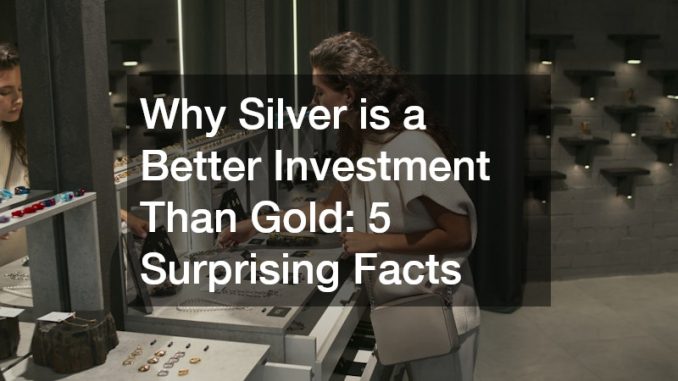

Gold has long been the poster child for precious metal investments, but savvy investors are now giving silver a second look. While both metals hold intrinsic value and serve as hedges against inflation, silver offers unique advantages that often go overlooked. From affordability to industrial demand, silver presents compelling opportunities that make it a strong addition—or even an alternative—to gold in a diversified portfolio.
If you’re among the financially savvy seeking to optimize your investment strategy, understanding the nuanced benefits of silver can help you make informed decisions. In this article, we break down five surprising facts that explain why silver is a better investment than gold, especially in today’s evolving economic landscape.
1. Silver Is More Affordable—But Just as Effective

One of the most immediate advantages of silver is its price. At a fraction of the cost of gold, silver allows investors to enter the market with significantly less capital. This affordability makes silver particularly attractive for those looking to diversify without tying up too much money in a single asset class.
- Lower entry point: While gold might be out of reach for many first-time investors, silver can be purchased in smaller units without compromising on potential.
- More liquidity for small investors: Because of its lower price, silver is easier to liquidate in small increments when needed.
Despite the price difference, silver performs similarly to gold in times of market instability, making it an effective store of value. Its price often moves in tandem with gold during economic uncertainty, providing a reliable hedge without the high upfront cost. This characteristic makes silver especially appealing for younger investors or those with smaller portfolios looking to add precious metals exposure.
2. Industrial Demand Is Driving Silver’s Growth
Silver isn’t just a financial asset—it’s also a critical industrial metal. Its unique properties make it irreplaceable in various technologies, from solar panels to electric vehicles and 5G infrastructure.
Why does this matter?
- Industrial use creates real demand: About 50% of silver’s demand comes from industrial applications, unlike gold, which is mostly used for jewelry and investment.
- Sustainable trends support long-term value: The global push toward green energy and electric mobility will only increase the need for silver.
This dual-purpose nature makes silver both a speculative and a fundamental investment. Its role in cutting-edge technology ensures demand will continue to grow, adding a layer of security to silver’s value proposition that gold cannot match. Additionally, silver’s antimicrobial properties have increased its usage in medical equipment and hygiene products, further expanding its industrial footprint.
3. Silver Is Historically Undervalued Compared to Gold
The gold-to-silver ratio has historically averaged around 50:1. In recent years, this ratio has often soared above 80:1 or even 100:1, suggesting that silver is currently undervalued compared to gold.
What does this mean for investors?
- Greater upside potential: If silver returns to its historical ratio with gold, it could experience significant price increases.
- Buy low, sell high strategy: Investors looking for growth opportunities often consider undervalued assets like silver for long-term gains.
For those asking, “Is silver a good investment?”, the current valuation metrics offer a strong case. Historically, when this ratio normalizes, silver has outperformed gold during the rebound periods. This cyclical dynamic makes silver a high-potential play for investors willing to tolerate some volatility for the chance of outsized returns.
4. Silver Offers More Practical Use in a Crisis
While both silver and gold are seen as “crisis hedges,” silver may offer greater practical utility in a financial emergency.
- Easier to trade: Silver coins and bars can be exchanged more easily than gold for goods and services in a barter situation.
- Smaller denominations: You wouldn’t want to break a gold bar to buy groceries—silver’s smaller denominations make it more versatile.
In a real-world economic collapse or severe inflationary event, silver could be more functional for day-to-day transactions than gold. Historically, silver has served as a currency medium, with coins circulating widely even in local economies. This liquidity and divisibility make it a more practical asset in times when traditional currency loses value.
5. Growing Investor Interest Is Fueling Momentum

Financially savvy individuals, including hedge funds and family offices, are beginning to increase their exposure to silver, especially in light of rising inflation and uncertain global markets.
Why the shift?
- Broader recognition of silver’s utility: Investors are realizing that silver offers both protection and growth potential.
- ETF and retail demand: Silver ETFs and physical bullion purchases have reached record highs in recent years.
This growing demand is creating a feedback loop: as more people invest in silver, the price continues to rise, attracting even more attention from the investment community. With silver mining production facing environmental and regulatory challenges, supply constraints could further tighten the market, supporting higher prices over time.
Why Silver is a Better Investment Than Gold: Final Thoughts
While gold remains a solid and respected asset, silver’s affordability, industrial demand, undervaluation, and practical usability make it a surprisingly strong contender. For those who want to hedge their portfolios while also positioning themselves for future gains, silver is an opportunity that shouldn’t be underestimated.
Whether you’re an experienced investor or just exploring alternatives to traditional asset classes, it’s time to ask not just “should I buy gold?”—but “should I be buying more silver instead?”